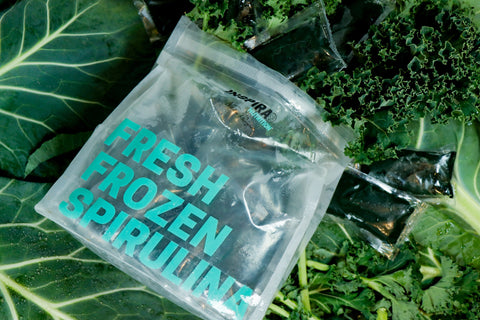
Why Fresh Frozen Spirulina is Better Than Greens Powders
Why Fresh Frozen Spirulina is Better Than Greens Powders
Greens powders are everywhere right now. They promise to give you the nutrition of vegetables and algae in a scoop. But here is the problem: most of those powders lose a lot of their power during processing. Heat, light, and oxygen break down delicate nutrients and antioxidants before you even open the container.
Fresh frozen spirulina is different. Because it is harvested and frozen right away, it locks in the natural pigments, enzymes, and vitamins that make it one of the most nutrient rich foods on earth.
What Happens to Greens Powders
When greens are dried into powders, fragile nutrients break down:
-
Chlorophyll and carotenoids are damaged by heat and light, which lowers their antioxidant effect [1].
-
Phycocyanin, the blue pigment in spirulina, quickly loses activity when it is dried [2].
-
Vitamin C and polyphenols, important antioxidants, are also reduced during processing [3].
So while greens powders may still have some nutritional value, they often deliver much less than the raw plants they came from.
Why Fresh Frozen Spirulina is Superior
Spirulina is a blue green algae that contains protein, vitamins, minerals, and unique compounds like phycocyanin and gamma linolenic acid. Freezing preserves these compounds almost completely. Studies show that freeze preservation keeps antioxidant levels far higher than drying methods [4].
That means with fresh frozen spirulina, you are getting the full anti inflammatory and antioxidant benefits, not just a fraction.
The Takeaway
Greens powders are convenient, but they are not the most effective way to get concentrated plant nutrition. Fresh frozen spirulina is the closest option to consuming spirulina in its natural state, with all of its delicate nutrients intact. If you want real antioxidant and anti inflammatory support, frozen spirulina is the clear choice.
References
[1] Grajek, W., Olejnik, A., & Sip, A. (2005). Probiotics, prebiotics and antioxidants as functional foods. Acta Biochimica Polonica, 52(3), 665–671.
[2] Patel, A., Mishra, S., Pawar, R., & Ghosh, P. K. (2006). Purification and characterization of C phycocyanin from cyanobacterial species of marine and freshwater habitat. Protein Expression and Purification, 40(2), 248–255.
[3] Zhang, D., & Hamauzu, Y. (2004). Phenolics, ascorbic acid, carotenoids and antioxidant activity of broccoli and their changes during conventional and microwave cooking. Food Chemistry, 88(4), 503–509.
[4] Tang, Y., Tsao, R., & Deng, Z. (2015). Freeze drying retains more antioxidant capacity and phenolic content in plant based foods compared to hot air drying. Food Chemistry, 188, 466–473.
